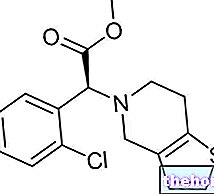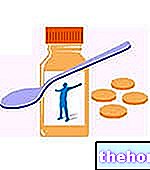Definition
Pulmonary fibrosis is a respiratory disease characterized by the formation of scar tissue that replaces normal lung tissue.
Scarring causes the lungs to harden, constricting the alveoli and thus hindering normal breathing.
There are basically two types of pulmonary fibrosis: idiopathic and secondary.
Causes
As for idiopathic pulmonary fibrosis - as its name suggests - at the moment, a real triggering cause has not yet been identified.
As for secondary pulmonary fibrosis, however, there are several possible causes that favor its development. Among these, we remember the exposure to toxic substances, some types of bacterial infections, the intake of some types of anticancer drugs, radiotherapy, some drugs used for the treatment of heart diseases and some autoimmune diseases (such as systemic lupus erythematosus , sarcoidosis, rheumatoid arthritis, scleroderma and Wegener's granulomatosis).
In addition, elderly patients, smokers, patients undergoing radiation therapy to the lung or breast, patients taking anticancer chemotherapy, farm workers or metallurgists, and individuals with a family history of pulmonary fibrosis, are prone to increased risk of developing the disease.
Symptoms
Symptoms that patients with pulmonary fibrosis may experience are dyspnoea, dry cough, chest pain, weight loss, fatigue, weakness, muscle and joint pain.
In addition, cyanosis, edema, hemothorax, respiratory acidosis, hypertrophy of the accessory muscles of respiration, pneumothorax, rales, wheezing, hypoxia, water retention and somnolence may also arise.
Finally, pulmonary fibrosis can promote the development of serious complications, such as respiratory failure, pulmonary hypertension, cor pulmonale and lung cancer.
The information on Pulmonary Fibrosis - Drugs and Care is not intended to replace the direct relationship between health professional and patient. Always consult your doctor and / or specialist before taking Pulmonary Fibrosis - Drugs and Treatment.
Medicines
Unfortunately, there are no real drugs to treat pulmonary fibrosis, as scar tissue is formed continuously and irreversibly. The pharmacological treatment used for this pathology, therefore, aims to reduce the symptoms and slow down their progress, in an attempt to improve the quality of life of the patients who suffer from it.
The drugs that are usually used in the treatment of pulmonary fibrosis are, mostly, corticosteroids and immunosuppressants.
In addition, oxygen therapy and respiratory rehabilitation can be very useful to limit the symptoms induced by pulmonary fibrosis.
In very serious cases and in cases where the aforementioned treatments are ineffective, however, the doctor may decide to intervene by carrying out a lung transplant.
In addition, patients diagnosed with pulmonary fibrosis should make lifestyle changes, avoiding both active and passive smoking, adopting a balanced diet and getting the flu shot and pneumonia vaccine, since - if contracted - these respiratory infections could further aggravate the symptoms induced by pulmonary fibrosis.

The following are the classes of drugs most used in the therapy against pulmonary fibrosis and some examples of pharmacological specialties; it is up to the doctor to choose the active ingredient and dosage most suitable for the patient, based on the severity of the disease, the state of health of the patient and his response to treatment.
Corticosteroids
As mentioned, corticosteroids can be used in the treatment of pulmonary fibrosis to try to limit its symptoms. They are used by virtue of their anti-inflammatory and immunosuppressive properties.
However, the use of these drugs should be done with caution and under close medical supervision, due to the serious side effects they can cause.
Among the various steroidal anti-inflammatories that can be used in the treatment of pulmonary fibrosis, we remember the:
- Prednisone (Deltacortene ®): Prednisone is available for oral administration. The usual dose of drug used is 5-15 mg per day. In any case, the exact amount of prednisone to be taken must be established by the doctor according to the severity of the disease and according to the patient's response to the treatment itself.
Immunosuppressants
Immunosuppressive drugs can be used in the treatment of pulmonary fibrosis, especially when it is caused by autoimmune diseases. In fact, these drugs are able to reduce the activity of the immune system.
Among the various active ingredients that can be used, we remember cyclosporine (Ciqorin ®, Sandimmun ®). It is a drug available in different pharmaceutical formulations suitable for different routes of administration, including oral and parenteral. The dose of active ingredient to be used must be established by the physician on an individual basis for each patient.
Pirfenidone
Pirfenidone (Esbriet ®) is a relatively recent drug (its use in Europe, in fact, was only approved in 2011) and which has specific therapeutic indications for the treatment of idiopathic pulmonary fibrosis.
It is a molecule with anti-inflammatory and antifibrotic activity, for these reasons it is particularly suitable for the treatment of this respiratory disease.
Pirfenidone is available for oral administration in the form of hard capsules.
Generally - during the first seven days of treatment - 267 mg of the drug is given three times a day with food.
Then - in the following seven days of treatment - the dose is increased to 534 mg of active ingredient, to be taken with food always three times a day.
From the fifteenth day of therapy onwards, however, the dose is further increased to 801 mg of pirfenidone three times a day, to be taken with food.
In any case, when the treatment based on pirfenidone is started, it is necessary to strictly follow all the instructions provided by the doctor, both as regards the quantity of drug to be taken, both as regards the frequency of administration and the duration of the same treatment.




























